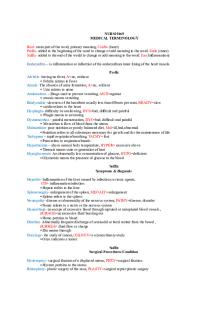Poetry terminology PDF

| Title | Poetry terminology |
|---|---|
| Author | Marietta Kosma |
| Course | English Language and Literature |
| Institution | University of Oxford |
| Pages | 2 |
| File Size | 54.5 KB |
| File Type | |
| Total Downloads | 15 |
| Total Views | 168 |
Summary
an analysis of terminology used in poetry...
Description
Poetry- basic terminology -
-
-
-
-
-
-
-
-
-
-
Alliteration: repetition of initial sounds in a series of words, e.g.: note the repetition of the letters b,y, and s in this excerpt from Edna St. St. Vincenet Millay’s “Countingout Rhyme”: Silver bark of beech, and sallow/ Bark of yellow birch and yellow Allusion: reference, often to literature, history, mythology, or the Bible that is unacknowledged in the text but that the author expects the reader to recognize. In the poem “On His Blindeness” John Milton alludes to the parable of the talents (from the book of Matthew 25:14-30) when he writes: And that one talent which is death to hide/ Lodged with me useless, though my soul more bent Archetype: image or symbol that is so common or significant to a culture that it seems to have a universal importance. This theory originates from Carl Jung who posited such things as a “tree”, for instance may represent “growth, life, unfolding of from in a physical and spiritual sense” Assonance: repetition of vowel sounds in a series of words, e.g.: All is seared with trade; bleared, smeared with toil; -- “God’s Grandeur” Gerald Manley Hopkins Blank verse: lines of unrhymed iambic parameter in no particular stanzaic form. Conceit: extended or complicated metaphor that is impressive largely because it shows off an author’s power to manipulate and sustain a striking comparison between two dissimilar items. A famous conceit occurs in John Donne’s “A Valediction: Forbidding Mourning” where he compares himself and his beloved to tow legs on a compass. Dramatic monologue: type of perfected by Robert Browning that consists of single speaker talking to one or more unseen listeners and often revealing more about the speaker than he or she seems to intend. End-stopped line: line of poetry that has a full pause at the end Enjambment: enjambment occurs when the sense of a poetic line runs over to the succeeding line, e.g.: In that blest moment from his oozy bed Old father Thames advanc’d his reverend head. –Alexander Pope Haiku: a Japanese poem in three lines, of 5, 7, and 5 syllables, which represents a clear picture so as to at once to arouse emotion and suggest spiritual insight, e.g.: The failing flower I saw drift back to the branch Was a butterfly – Moritake. Hyperbole: figurative speech that depends on intentional overstatement or exaggeration. In the poem “To His Coy Mistress” Andrew Marvell uses hyperbole when he declares that “if there were world enough and time” he’d spend centuries adoring each part of his lover’s body. Imagery: words and phrases that describe the concrete experience of the five sense, e.g.: Nothing is so beautiful as spring—When weeds, in wheels, shoot long and lovely and lush; Thrush’s eggs look like low heavens… -- “Spring” Gerard Manley Hopkins Metaphor: concise form of comparison equating two things that may seem at first dissimilar, e.g.: Life the hound/ Equivocal/ Comes at a bound/ Either to rend me/ Or to befriend me. –Robert Francis. Meter: regular pattern of stressed and unstressed syllables, each repeated unit of which is called a foot (iamb, torchee, anapest, dactyl, spondee, pyrrhic). Onomatopoeia: word whose sound resembles what is describes (snap, crackle, pop).
-
-
-
Oxymoron: phrase combining two seemingly incompatible elements (“darkness visible”). Personification: attributing of human qualities to things that are not human, e.g.: in the following excerpt Sylvia Plath gives a “mirror” human qualities: I am silver and exact, I have no preconceptions. Whatever I see I shallow immediately. Simile: comparison of two seemingly unlike things using the words like or as. Toni Morrison uses a startling simile in The Bluest Eye when she writes: “Nuns go by as quiet as lust.” Sonnet: a fourteen line poem following a strict rhyming scheme. Stanza: group of lines in a poem that forms a metrical or thematic unit....
Similar Free PDFs

Poetry terminology
- 2 Pages

Poetry
- 21 Pages

Poetry
- 1 Pages

Understanding Poetry
- 4 Pages

Poetry Explication
- 3 Pages

Immunology Terminology
- 2 Pages

Music Terminology
- 11 Pages

Sonographic terminology
- 2 Pages

Medical Terminology
- 6 Pages

Medical Terminology
- 2 Pages

Github terminology
- 4 Pages

Medical Terminology
- 4 Pages

Cruise Terminology
- 2 Pages

Medical Terminology
- 50 Pages

Music As Poetry Assignment
- 3 Pages
Popular Institutions
- Tinajero National High School - Annex
- Politeknik Caltex Riau
- Yokohama City University
- SGT University
- University of Al-Qadisiyah
- Divine Word College of Vigan
- Techniek College Rotterdam
- Universidade de Santiago
- Universiti Teknologi MARA Cawangan Johor Kampus Pasir Gudang
- Poltekkes Kemenkes Yogyakarta
- Baguio City National High School
- Colegio san marcos
- preparatoria uno
- Centro de Bachillerato Tecnológico Industrial y de Servicios No. 107
- Dalian Maritime University
- Quang Trung Secondary School
- Colegio Tecnológico en Informática
- Corporación Regional de Educación Superior
- Grupo CEDVA
- Dar Al Uloom University
- Centro de Estudios Preuniversitarios de la Universidad Nacional de Ingeniería
- 上智大学
- Aakash International School, Nuna Majara
- San Felipe Neri Catholic School
- Kang Chiao International School - New Taipei City
- Misamis Occidental National High School
- Institución Educativa Escuela Normal Juan Ladrilleros
- Kolehiyo ng Pantukan
- Batanes State College
- Instituto Continental
- Sekolah Menengah Kejuruan Kesehatan Kaltara (Tarakan)
- Colegio de La Inmaculada Concepcion - Cebu
